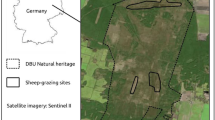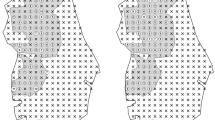Abstract
Livestock production is the primary source of livelihood and income in most of the high steppe and alpine regions of the Indian Trans-Himalaya. In some areas, especially those established or proposed for biodiversity conservation, recent increases in populations of domestic livestock, primarily sheep and goats, have raised concern about domestic animals competitively excluding wild herbivores from the rangelands. We evaluated the influence of domestic sheep and goat grazing on the habitat use and time budget of the endangered Tibetan argali Ovis ammon hodgsoni in the proposed Gya-Miru Wildlife Sanctuary, Ladakh, India. We asked if the domestic sheep and goat grazing and collateral human activities relegate the argali to sub-optimal habitats, and alter their foraging time budgets. Data were collected on habitat use and time budget of a population of c. 50 argalis before and after c. 2,000 sheep and goats moved onto their winter pasture in the Tsabra catchment of the aforementioned reserve. Following the introduction of domestic sheep and goats, argalis continued to use the same catchment but shifted to steeper habitats, closer to cliffs, with lower vegetation cover, thus abandoning previously used plant communities with denser cover. Argalis’ active time spent foraging also decreased by 10% in response to the presence of livestock. These results suggest a clear disturbance effect of livestock on argalis, and indicate a potential for competition, conceivably a significant disadvantage for argalis in winter when forage availability is minimal.




Similar content being viewed by others
References
Altmann J (1974) Observational study of behaviour: sampling methods. Behaviour 49:227–267
Anonymous (2002) Annual report for 2001–2002. Sheep Husbandry Department, Ladakh, India
Bagchi S, Mishra C, Bhatnagar YV (2004) Conflicts between traditional pastoralism and conservation of Himalayan ibex (Capra sibrica) in the Trans-Himalayan mountains. Anim Conserv 7:121–128
Bhatnagar YV, Mishra C, Wangchuk R (2006). Decline of the Tibetan gazelle in Ladakh. Oryx (in press)
Brown LH (1971) The biology of pastoral man as a factor in conservation. Biol Conserv 3:93–100
Burnham KP, Anderson DR (1998) Model selection and inference: a practical information theoretic approach. Springer, Berlin Heidelberg New York
Case TJ, Bolger DT (1991) The role of interspecific competition in the biogeography of island lizards. Trends Ecol Evol 6:135–139
Case TJ, Gilpin ME (1974) Interference competition in niche theory. Proc Natl Acad Sci USA 71:3073–3077
Clutton-Brock TH, Guiness FE, Albon SD (1982) Red deer: behaviour and ecology of two sexes. University of Chicago Press, Chicago
Cohen WE, Drawe DL, Bryant FC, Bradley LC (1989) Observations on white-tailed deer and habitat response to livestock grazing in South Texas. J Range Manage 42:361–365
Connell JH (1961) The influence of interspecific competition and other factors on the distribution of the barnacle Chthamalus stellatus. Ecology 42:710–723
Diamond JM (1978) Niche shifts and the rediscovery of interspecific competition. Am Scient 66:322–331
Ellisor JE (1969) Mobility of white-tailed deer in South Texas. J Wildl Manage 33:220–222
Fox JL, Johnsingh AJT (1997) Country report for India. In: Shackleton DM (eds) Wild sheep and goats and their relatives. IUCN, Gland, pp 215–231
Fox JL, Tsering D (2005) Biodiversity conservation and natural resource exploitation on Tibet’s northwest Chang Tang highlands. In: Boesi A, Cardi F (eds) Wildlife and plants in traditional and modern Tibet: conceptions, exploitation and conservation. Memorie della Società Italiana di Scienze Naturali e del Museo Civico di Storia Naturale di Milano, pp 49–57
Fox JL, Nurbu C, Chundawat RS (1991a) Tibetan argali (Ovis ammon hodgsoni) establish a new population. Mammalia 55:448–451
Fox JL, Nurbu C, Chundawat RS (1991b) Mountain ungulates of Ladakh, India. Biol Conserv 58:167–190
Fritz H, de Garine-Wichatitsky M, Letessier G (1996) Habitat use by sympatric wild and domestic herbivores in an African savanna woodland: the influence of cattle spatial behaviour. J Appl Ecol 33:589–598
Goldstein MC, Beall CM, Cincotta RP (1990) Traditional nomadic pastoralism and ecological conservation on Tibet’s northern plateau. Nat Geo Res 6:139–156
Harris RB, Bedunah DJ (2001) Sheep vs. sheep: Argali and livestock in western China. Unpublished final report. National Geographic Society
Homewood K, Rodgers WA (1991) Maasailand ecology: pastoral development and wildlife conservation in Ngorongoro, Tanzania. Cambridge University Press, Cambridge
Lawton J, Hassell M (1981) Asymmetrical competition in insects. Nature 289:793–795
Lima SL, Dill LM (1990) Behavioural decisions made under the risk of predation: a review and prospectus. Can J Zool 68:619–640
Loft ER, Menke JW, Kie JG (1991) Habitat shift by mule deer: the influence of cattle grazing. J Wildl Manage 55:16–26
Machlis L, Dodd PWD, Fentress JC (1985) The pooling fallacy: problems arising when individuals contribute more than one observation to the data set. Z Tierpsychol 68:201–214
Mallon DP (1991) Status and conservation of large mammals in Ladakh. Biol Conserv 56:101–119
Mishra C, Prins HHT, Van Wieren SE (2001) Overstocking in the Trans-Himalayan rangelands of India. Environ Conserv 28:279–283
Mishra C, Van Wieren SE, Ketner P, Heitkonig IMA, Prins HHT (2004) Competition between domestic livestock and wild bharal Pseudois nayaur in the Indian Trans-Himalaya. J Appl Ecol 41:344–354
Morin PJ, Johnson EA (1988) Experimental studies of asymmetric competition among anurans. Oikos 53:398–407
Namgail T (2001) Habitat selection and ecological separation between sympatric Tibetan argali and blue sheep in northern India. M.Phil. Thesis, University of Tromsø, Norway
Namgail T (2005) Winter birds of the Gya-Miru wildlife sanctuary, Ladakh, Jammu and Kashmir, India. Indian Birds 1:26–28
Namgail T, Fox JL, Bhatnagar YV (2004a) Habitat segregation between sympatric Tibetan argali Ovis ammon hodgsoni and blue sheep Pseudois nayaur in the Indian Trans-Himalaya. J Zool (Lond) 262:57–63
Namgail T, Fox JL, Bhatnagar YV (2004b) Argali and livestock: friends or foes? Nature of interaction between argali and domestic sheep and goats in a prospective Trans-Himalayan wildlife reserve. Technical Report submitted to the Wildlife Institute of India-University of Tromsø NORAD Institutional Cooperation Programme and the International Snow Leopard Trust, Seattle
Norussis MJ (1997) Statistical package for social sciences (SPSS) 7.5. SPSS Inc., Chicago
Pelabon C, Komers PE (1997) Time-budget variations in relation to density-dependent social interactions in female and yearling male fallow deer during the rut. Can J Zool 75:971–977
Prins HHT (1992) The pastoral road to extinction: competition between wildlife and traditional pastoralism in East Africa. Environ Conserv 19:117–123
Rukstuhl KE (1998) Foraging behaviour and sexual segregation in bighorn sheep. Anim Behav 56:99–106
Schaller GB (1977). Mountain monarchs: wild sheep and goats of the Himalaya. University of Chicago Press, Chicago
Schaller GB (1998) Wildlife of the Tibetan steppe. University of Chicago Press, Chicago
Schoener TW (1983) Field experiments on interspecific competition. Am Nat 122:240–285
Stevens DR (1966) Range relationships of elk and livestock, Crow Creek Drainage, Montana. J Wildl Manage 30:349–363
Acknowledgments
The study was funded by the University of Tromsø–Wildlife Institute of India (WII) Norwegian Aid for Development (NORAD)-supported Institutional Cooperation Program. The International Snow Leopard Trust (ISLT) and the Wildlife Protection Society of India (WPSI) are also acknowledged for additional support. We are thankful to Mr. Salim Ul-Haq and Mr. Jigmet Takpa, Department of Wildlife Protection, Leh for assisting us in the permission process for our work in the area. We thank Dr. Charudutt Mishra for his comments on the manuscript. We also thank reviewers Drs. Richard B. Harris, Marco Festa-Bianchet and Barry W. Brook for their comments on an earlier draft of the manuscript. The field assistance of Messrs. Thinles Dorjey, Tashi Gyatso, Tsewang Morup and Thinles Yangjor is gratefully acknowledged.
Author information
Authors and Affiliations
Corresponding author
About this article
Cite this article
Namgail, T., Fox, J.L. & Bhatnagar, Y.V. Habitat shift and time budget of the Tibetan argali: the influence of livestock grazing. Ecol Res 22, 25–31 (2007). https://doi.org/10.1007/s11284-006-0015-y
Received:
Accepted:
Published:
Issue Date:
DOI: https://doi.org/10.1007/s11284-006-0015-y




